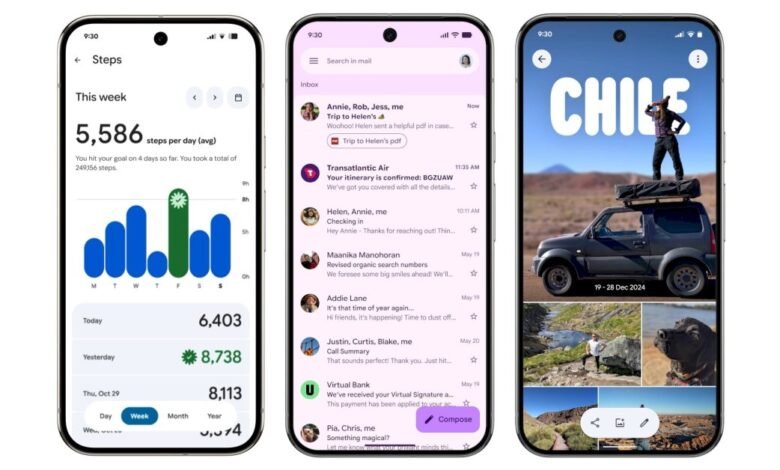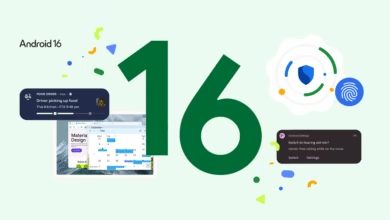Google Material 3’s Expressive Redesign Is Here [Updated]

▼ Summary
– Google’s Material 3 Expressive design language is being rolled out across its apps, with the Pixel 10 and Android 16 QPR1 launch accelerating its adoption.
– Recent updates include redesigned interfaces for Google Wallet, Google Home, and the Pixel Watch companion app, featuring new icons, floating action buttons, and containers.
– Apps like Gmail, Google Chrome, and Digital Wellbeing are receiving ongoing updates with containers, progress indicators, and pill-shaped elements for improved visuals.
– Fully launched redesigns affect apps such as Google Calendar, Google Messages, and Google Photos, incorporating containers, new animations, and updated navigation bars.
– The redesign aims to simplify interfaces and enhance usability, with apps like Phone by Google and Pixel Recorder undergoing significant overhauls to streamline features.
Google’s Material 3 Expressive design language has officially arrived, bringing a fresh visual identity to its ecosystem of apps and services. This comprehensive redesign emphasizes dynamic color theming, improved usability, and consistent visual elements across Android and Pixel devices. Following its initial announcement earlier this year, the rollout has accelerated with recent hardware and software launches, transforming how users interact with Google’s digital products.
The Pixel Watch II companion application now showcases an updated icon and expanded Material 3 implementation. What began as a homepage refresh has evolved into a full interface transformation, with all menus now featuring distinct containers that create clearer visual organization.
Google Wallet presents several notable changes. The traditional “Wallet” text in the upper-left corner has been replaced by the application’s logo, while a prominent floating action button now handles adding new items. Throughout the application, settings and recent activity sections utilize the new container system. The NFC payment animation has been revitalized with translucent backgrounds and more dynamic card movements. Newer Pixel devices also feature an enhanced overlay when using the double-tap power button gesture.
The Google Home application incorporates several Material 3 Expressive elements, including morphing buttons that transition smoothly between home feed tabs and within automation creation. The “Ask Home” field functions similarly to a search application bar, and the glowing effect during app launch provides a delightful user experience, though the bottom navigation bar remains notably tall.
Several applications are currently in various stages of receiving the Material 3 treatment. Gmail’s ongoing redesign places individual messages within containers on the homepage, creating subtle left and right borders. Google Chrome now features a segmented progress indicator during browsing, circular containers for overflow menu actions, and enhanced tab group cards that prominently display selected colors.
Among fully launched applications, Digital Wellbeing within Settings displays a thicker donut chart alongside container implementations. Files by Google introduces an animated carousel on its homepage with pill-shaped toolbars for Quick Share and document scanning, plus larger previews in list views.
Find Hub features a more compact bottom bar with prominently rounded corners and larger device pins for improved usability. Gmail containers both email lists and individual messages while incorporating pill-shaped animations for swipe gestures. The search application bar has been reconfigured to move navigation elements outside the pill-shaped field.
Google Calculator version 9.0 conceals scientific functions by default while adding a history button. Google Calendar places time slots within rounded containers across all views, replacing previous faint lines with solid background layers in dynamic colors. A floating action button menu now handles event, task, and other creation functions, while widgets gain pill-shaped buttons in their upper-right corners.
Google Chat implements a chat application bar and contains message lists, with a floating toolbar using pills to indicate active tabs. Google Clock version 8.1 features a shorter bottom bar, new typography, and a rounded square floating action button.
The Google Docs, Sheets, and Slides suite updates their editor interfaces with new progress indicators during document loading. Pill-shaped buttons appear throughout, and the format sheet receives comprehensive modernization including split button components.
Google Drive incorporates a search application bar, compact bottom navigation, floating action button menus, and contained line items. Its camera scanner benefits from a redesigned editor utilizing Material 3 principles.
Google Keep employs the new search application bar component that relocates navigation elements outside the thicker search field. The notes page contains all action buttons within distinctive containers.
Google Maps listings now use containers to better organize information, while the actions carousel appears more consistently at screen bottom. Google Meet pioneered the widespread Material 3 rollout, featuring large call cards and redesigned pre-call screens with proportionally larger voice and video buttons.
Google Messages contains both conversation lists and message threads while redesigning the additional options menu with pill-shaped buttons. Google One transitions to a shorter bottom bar with more prominent card containers and removes infographics for a denser layout.
Google Password Manager introduces a new search application bar with filters for different credential types, all contained within the new design framework. Google Photos replaces its name with a backup indicator and features animated logos, pull-to-refresh with cycling shapes, and wavy progress indicators during uploads.
Google TV implements a shorter bottom bar with white accent colors and updated remote button shapes. The Pixel Tips application has been rebranded as “My Pixel” with added support options and full store integration.
Phone by Google represents one of the most comprehensive redesigns, consolidating four tabs into three with Favorites and Recents merging into “Home.” A new “Keypad” tab replaces the floating action button, while contacts move to a navigation drawer. All call interfaces and lists utilize containers, with incoming and active call screens featuring larger touch targets and updated interaction options.
Pixel Buds focus updates on equalizer customization and gesture controls. Pixel Recorder simplifies its interface with overflow sheets for most actions and a streamlined capture experience. Pixel Screenshots introduces a rounded square floating action button among other refinements.
Pixel Studio 2.0 drops its preview status while introducing a new image editor that generally replaces Markup. The Material 3 Expressive design incorporates crop, draw, highlight, and caption tools alongside generative AI capabilities for creating stickers, erasing content, and modifying selections through prompts.
Pixel VIPs transitions from circular to pill-shaped containers. Pixel Weather expands city card sizes on its homepage, reducing visible locations from ten to six while incorporating high and low temperature information. The application also introduces native home screen widgets. Quick Share now offers a fullscreen experience fully leveraging the Material 3 Expressive design language.
This system-wide visual refresh represents Google’s commitment to creating a more cohesive, intuitive, and visually appealing ecosystem across its product lineup.
(Source: 9to5 Google)

